Dyah Adila
CrEst: Credibility Estimation for Contexts in LLMs via Weak Supervision
Jun 17, 2025Abstract:The integration of contextual information has significantly enhanced the performance of large language models (LLMs) on knowledge-intensive tasks. However, existing methods often overlook a critical challenge: the credibility of context documents can vary widely, potentially leading to the propagation of unreliable information. In this paper, we introduce CrEst, a novel weakly supervised framework for assessing the credibility of context documents during LLM inference--without requiring manual annotations. Our approach is grounded in the insight that credible documents tend to exhibit higher semantic coherence with other credible documents, enabling automated credibility estimation through inter-document agreement. To incorporate credibility into LLM inference, we propose two integration strategies: a black-box approach for models without access to internal weights or activations, and a white-box method that directly modifies attention mechanisms. Extensive experiments across three model architectures and five datasets demonstrate that CrEst consistently outperforms strong baselines, achieving up to a 26.86% improvement in accuracy and a 3.49% increase in F1 score. Further analysis shows that CrEst maintains robust performance even under high-noise conditions.
Personalize Your LLM: Fake it then Align it
Mar 05, 2025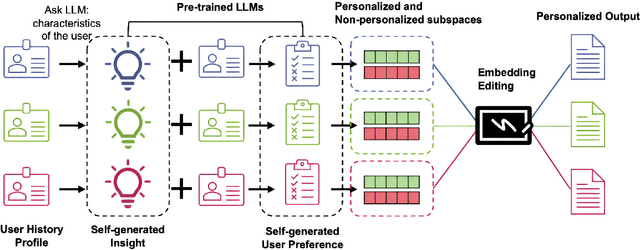

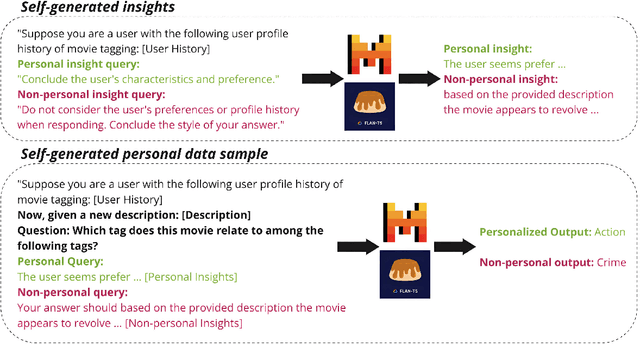

Abstract:Personalizing large language models (LLMs) is essential for delivering tailored interactions that improve user experience. Many existing personalization methods require fine-tuning LLMs for each user, rendering them prohibitively expensive for widespread adoption. Although retrieval-based approaches offer a more compute-efficient alternative, they still depend on large, high-quality datasets that are not consistently available for all users. To address this challenge, we propose CHAMELEON, a scalable and efficient personalization approach that uses (1) self-generated personal preference data and (2) representation editing to enable quick and cost-effective personalization. Our experiments on various tasks, including those from the LaMP personalization benchmark, show that CHAMELEON efficiently adapts models to personal preferences, improving instruction-tuned models and outperforms two personalization baselines by an average of 40% across two model architectures.
Is Free Self-Alignment Possible?
Jun 05, 2024Abstract:Aligning pretrained language models (LMs) is a complex and resource-intensive process, often requiring access to large amounts of ground-truth preference data and substantial compute. Are these costs necessary? That is, it is possible to align using only inherent model knowledge and without additional training? We tackle this challenge with AlignEZ, a novel approach that uses (1) self-generated preference data and (2) representation editing to provide nearly cost-free alignment. During inference, AlignEZ modifies LM representations to reduce undesirable and boost desirable components using subspaces identified via self-generated preference pairs. Our experiments reveal that this nearly cost-free procedure significantly narrows the gap between base pretrained and tuned models by an average of 31.6%, observed across six datasets and three model architectures. Additionally, we explore the potential of using AlignEZ as a means of expediting more expensive alignment procedures. Our experiments show that AlignEZ improves DPO models tuned only using a small subset of ground-truth preference data. Lastly, we study the conditions under which improvement using AlignEZ is feasible, providing valuable insights into its effectiveness.
Discovering Bias in Latent Space: An Unsupervised Debiasing Approach
Jun 05, 2024Abstract:The question-answering (QA) capabilities of foundation models are highly sensitive to prompt variations, rendering their performance susceptible to superficial, non-meaning-altering changes. This vulnerability often stems from the model's preference or bias towards specific input characteristics, such as option position or superficial image features in multi-modal settings. We propose to rectify this bias directly in the model's internal representation. Our approach, SteerFair, finds the bias direction in the model's representation space and steers activation values away from it during inference. Specifically, we exploit the observation that bias often adheres to simple association rules, such as the spurious association between the first option and correctness likelihood. Next, we construct demonstrations of these rules from unlabeled samples and use them to identify the bias directions. We empirically show that SteerFair significantly reduces instruction-tuned model performance variance across prompt modifications on three benchmark tasks. Remarkably, our approach surpasses a supervised baseline with 100 labels by an average of 10.86% accuracy points and 12.95 score points and matches the performance with 500 labels.
Zero-Shot Robustification of Zero-Shot Models With Foundation Models
Sep 08, 2023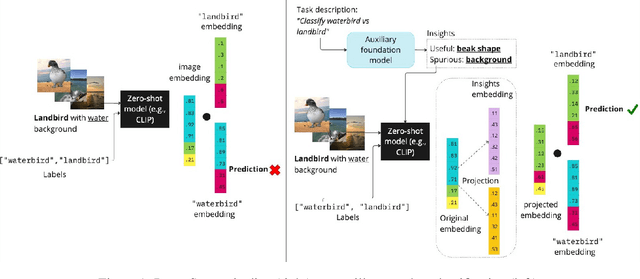
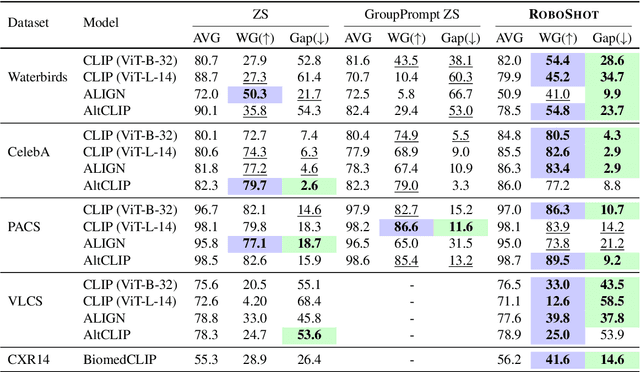
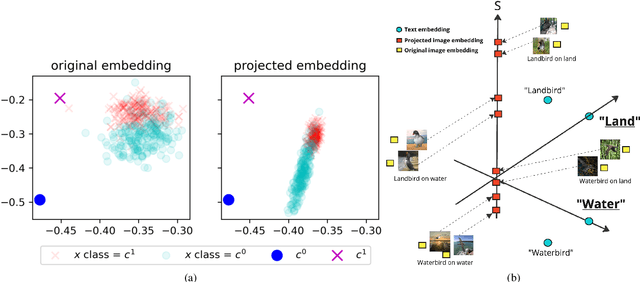
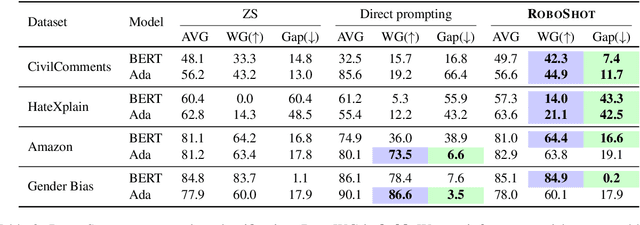
Abstract:Zero-shot inference is a powerful paradigm that enables the use of large pretrained models for downstream classification tasks without further training. However, these models are vulnerable to inherited biases that can impact their performance. The traditional solution is fine-tuning, but this undermines the key advantage of pretrained models, which is their ability to be used out-of-the-box. We propose RoboShot, a method that improves the robustness of pretrained model embeddings in a fully zero-shot fashion. First, we use zero-shot language models (LMs) to obtain useful insights from task descriptions. These insights are embedded and used to remove harmful and boost useful components in embeddings -- without any supervision. Theoretically, we provide a simple and tractable model for biases in zero-shot embeddings and give a result characterizing under what conditions our approach can boost performance. Empirically, we evaluate RoboShot on nine image and NLP classification tasks and show an average improvement of 15.98% over several zero-shot baselines. Additionally, we demonstrate that RoboShot is compatible with a variety of pretrained and language models.
Geometry-Aware Adaptation for Pretrained Models
Jul 23, 2023Abstract:Machine learning models -- including prominent zero-shot models -- are often trained on datasets whose labels are only a small proportion of a larger label space. Such spaces are commonly equipped with a metric that relates the labels via distances between them. We propose a simple approach to exploit this information to adapt the trained model to reliably predict new classes -- or, in the case of zero-shot prediction, to improve its performance -- without any additional training. Our technique is a drop-in replacement of the standard prediction rule, swapping argmax with the Fr\'echet mean. We provide a comprehensive theoretical analysis for this approach, studying (i) learning-theoretic results trading off label space diameter, sample complexity, and model dimension, (ii) characterizations of the full range of scenarios in which it is possible to predict any unobserved class, and (iii) an optimal active learning-like next class selection procedure to obtain optimal training classes for when it is not possible to predict the entire range of unobserved classes. Empirically, using easily-available external metrics, our proposed approach, Loki, gains up to 29.7% relative improvement over SimCLR on ImageNet and scales to hundreds of thousands of classes. When no such metric is available, Loki can use self-derived metrics from class embeddings and obtains a 10.5% improvement on pretrained zero-shot models such as CLIP.
Mitigating Source Bias for Fairer Weak Supervision
Mar 30, 2023Abstract:Weak supervision overcomes the label bottleneck, enabling efficient development of training sets. Millions of models trained on such datasets have been deployed in the real world and interact with users on a daily basis. However, the techniques that make weak supervision attractive -- such as integrating any source of signal to estimate unknown labels -- also ensure that the pseudolabels it produces are highly biased. Surprisingly, given everyday use and the potential for increased bias, weak supervision has not been studied from the point of view of fairness. This work begins such a study. Our departure point is the observation that even when a fair model can be built from a dataset with access to ground-truth labels, the corresponding dataset labeled via weak supervision can be arbitrarily unfair. Fortunately, not all is lost: we propose and empirically validate a model for source unfairness in weak supervision, then introduce a simple counterfactual fairness-based technique that can mitigate these biases. Theoretically, we show that it is possible for our approach to simultaneously improve both accuracy and fairness metrics -- in contrast to standard fairness approaches that suffer from tradeoffs. Empirically, we show that our technique improves accuracy on weak supervision baselines by as much as 32% while reducing demographic parity gap by 82.5%.
AutoWS-Bench-101: Benchmarking Automated Weak Supervision with 100 Labels
Aug 30, 2022
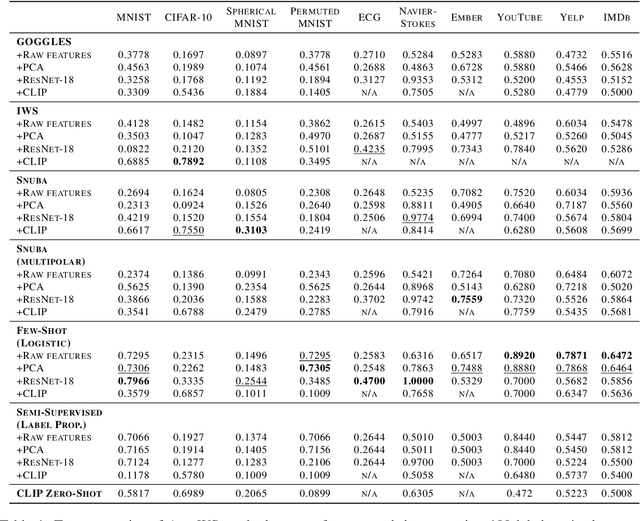

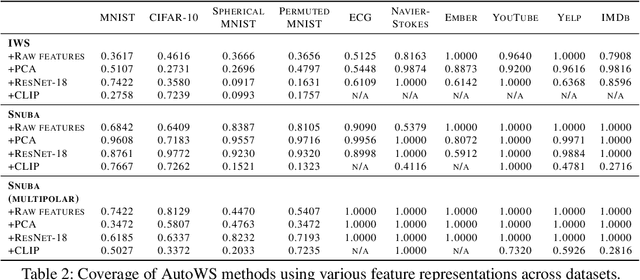
Abstract:Weak supervision (WS) is a powerful method to build labeled datasets for training supervised models in the face of little-to-no labeled data. It replaces hand-labeling data with aggregating multiple noisy-but-cheap label estimates expressed by labeling functions (LFs). While it has been used successfully in many domains, weak supervision's application scope is limited by the difficulty of constructing labeling functions for domains with complex or high-dimensional features. To address this, a handful of methods have proposed automating the LF design process using a small set of ground truth labels. In this work, we introduce AutoWS-Bench-101: a framework for evaluating automated WS (AutoWS) techniques in challenging WS settings -- a set of diverse application domains on which it has been previously difficult or impossible to apply traditional WS techniques. While AutoWS is a promising direction toward expanding the application-scope of WS, the emergence of powerful methods such as zero-shot foundation models reveals the need to understand how AutoWS techniques compare or cooperate with modern zero-shot or few-shot learners. This informs the central question of AutoWS-Bench-101: given an initial set of 100 labels for each task, we ask whether a practitioner should use an AutoWS method to generate additional labels or use some simpler baseline, such as zero-shot predictions from a foundation model or supervised learning. We observe that in many settings, it is necessary for AutoWS methods to incorporate signal from foundation models if they are to outperform simple few-shot baselines, and AutoWS-Bench-101 promotes future research in this direction. We conclude with a thorough ablation study of AutoWS methods.
Shoring Up the Foundations: Fusing Model Embeddings and Weak Supervision
Mar 24, 2022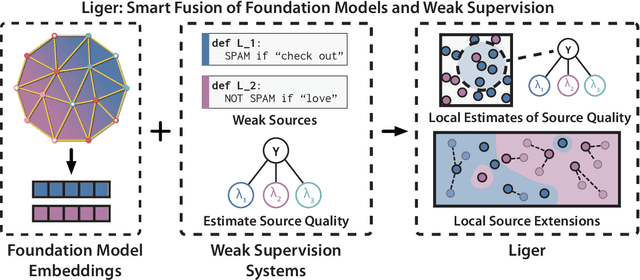


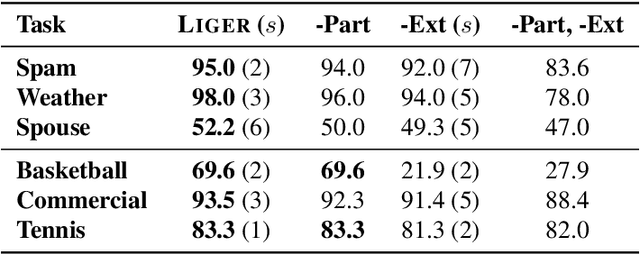
Abstract:Foundation models offer an exciting new paradigm for constructing models with out-of-the-box embeddings and a few labeled examples. However, it is not clear how to best apply foundation models without labeled data. A potential approach is to fuse foundation models with weak supervision frameworks, which use weak label sources -- pre-trained models, heuristics, crowd-workers -- to construct pseudolabels. The challenge is building a combination that best exploits the signal available in both foundation models and weak sources. We propose Liger, a combination that uses foundation model embeddings to improve two crucial elements of existing weak supervision techniques. First, we produce finer estimates of weak source quality by partitioning the embedding space and learning per-part source accuracies. Second, we improve source coverage by extending source votes in embedding space. Despite the black-box nature of foundation models, we prove results characterizing how our approach improves performance and show that lift scales with the smoothness of label distributions in embedding space. On six benchmark NLP and video tasks, Liger outperforms vanilla weak supervision by 14.1 points, weakly-supervised kNN and adapters by 11.8 points, and kNN and adapters supervised by traditional hand labels by 7.2 points.
Understanding Out-of-distribution: A Perspective of Data Dynamics
Nov 29, 2021
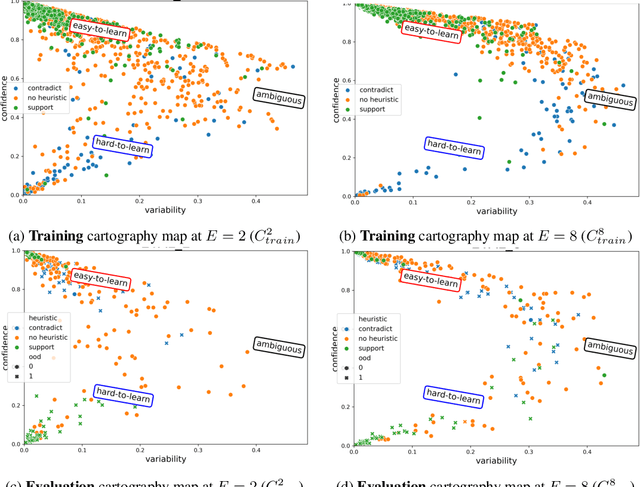
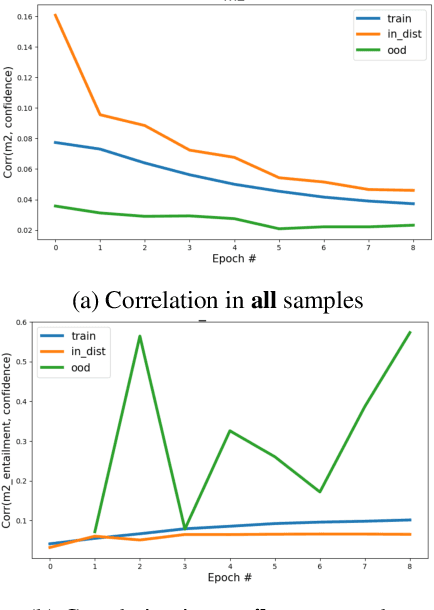
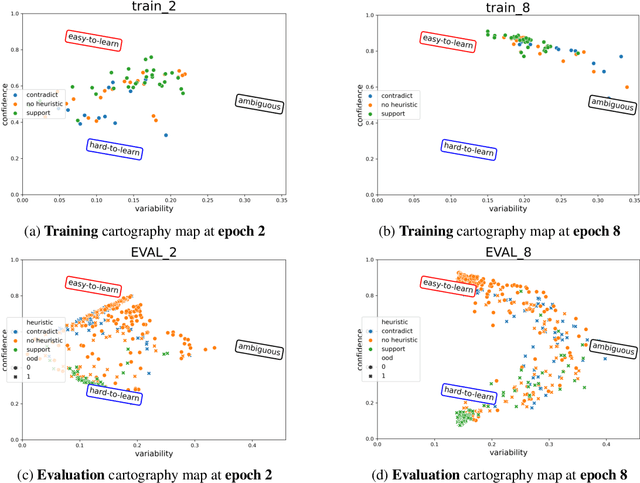
Abstract:Despite machine learning models' success in Natural Language Processing (NLP) tasks, predictions from these models frequently fail on out-of-distribution (OOD) samples. Prior works have focused on developing state-of-the-art methods for detecting OOD. The fundamental question of how OOD samples differ from in-distribution samples remains unanswered. This paper explores how data dynamics in training models can be used to understand the fundamental differences between OOD and in-distribution samples in extensive detail. We found that syntactic characteristics of the data samples that the model consistently predicts incorrectly in both OOD and in-distribution cases directly contradict each other. In addition, we observed preliminary evidence supporting the hypothesis that models are more likely to latch on trivial syntactic heuristics (e.g., overlap of words between two sentences) when making predictions on OOD samples. We hope our preliminary study accelerates the data-centric analysis on various machine learning phenomena.
 Add to Chrome
Add to Chrome Add to Firefox
Add to Firefox Add to Edge
Add to Edge